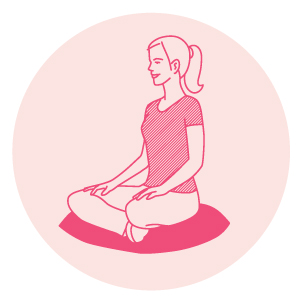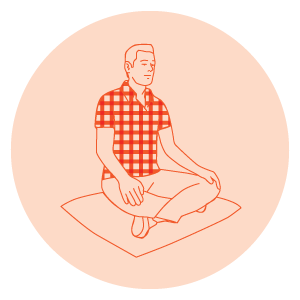Basics of Mindfulness & Meditation

Mediation is all about being mindful. Something I found very challenging in the beginning. I began my search by going to mindfulness.org to learn more and here is the article that helped get me focused.
 While mindfulness is something we all naturally possess, it’s more readily available to us when we practice on a daily basis.
While mindfulness is something we all naturally possess, it’s more readily available to us when we practice on a daily basis.
Whenever you bring awareness to what you’re directly experiencing via your senses, or to your state of mind via your thoughts and emotions, you’re being mindful. And there’s growing research showing that when you train your brain to be mindful, you’re actually remodeling the physical structure of your brain.
Anyone can do mindfulness practice. There are no barriers. It doesn’t matter how old you are, what your physical ability is, if you’re religious or not…
Mindfulness is not obscure or exotic. It’s familiar to us because it’s what we already do, how we already are. It takes many shapes and goes by many names.
We all already have the capacity to be present, and it doesn’t require us to change who we are. But we can cultivate these innate qualities with simple practices that are scientifically demonstrated to benefit us in many ways.
The Basics of Mindfulness Practice
Mindfulness helps us put some space between ourselves and our reactions, breaking down our conditioned responses. Here’s how to tune into mindfulness throughout the day:

1Set aside some time. You don’t need a meditation cushion or bench, or any sort of special equipment to access your mindfulness skills—but you do need to set aside some time and space.
2Observe the present moment as it is. The aim of mindfulness is not quieting the mind, or attempting to achieve a state of eternal calm. The goal is simple: we’re aiming to pay attention to the present moment, without judgement. Easier said than done, we know.
3Let your judgements roll by. When we notice judgements arise during our practice, we can make a mental note of them, and let them pass.
4Return to observing the present moment as it is. Our minds often get carried away in thought. That’s why mindfulness is the practice of returning, again and again, to the present moment.
5Be kind to your wandering mind. Don’t judge yourself for whatever thoughts crop up, just practice recognizing when your mind has wandered off, and gently bring it back.
That’s the practice. It’s often been said that it’s very simple, but it’s not necessarily easy. The work is to just keep doing it. Results will accrue.
A Simple Meditation Practice
 1Sit comfortably. Find a spot that gives you a stable, solid, comfortable seat.
1Sit comfortably. Find a spot that gives you a stable, solid, comfortable seat.
2Notice what your legs are doing. If on a cushion, cross your legs comfortably in front of you. If on a chair, rest the bottoms of your feet on the floor.
3Straighten your upper body—but don’t stiffen. Your spine has natural curvature. Let it be there.
4Notice what your arms are doing. Situate your upper arms parallel to your upper body. Rest the palms of your hands on your legs wherever it feels most natural.
5Soften your gaze. Drop your chin a little and let your gaze fall gently downward. It’s not necessary to close your eyes. You can simply let what appears before your eyes be there without focusing on it.
6Feel your breath. Bring your attention to the physical sensation of breathing: the air moving through your nose or mouth, the rising and falling of your belly, or your chest.
7Notice when your mind wanders from your breath. Inevitably, your attention will leave the breath and wander to other places. Don’t worry. There’s no need to block or eliminate thinking. When you notice your mind wandering gently return your attention to the breath.
8Be kind about your wandering mind. You may find your mind wandering constantly—that’s normal, too. Instead of wrestling with your thoughts, practice observing them without reacting. Just sit and pay attention. As hard as it is to maintain, that’s all there is. Come back to your breath over and over again, without judgment or expectation.
9When you’re ready, gently lift your gaze (if your eyes are closed, open them). Take a moment and notice any sounds in the environment. Notice how your body feels right now. Notice your thoughts and emotions.
Here is a simple 3 minute audio to get you started!
[soundcloud url=”https://api.soundcloud.com/tracks/253873585″ params=”auto_play=false&hide_related=false&show_comments=true&show_user=true&show_reposts=false&visual=true” width=”100%” height=”450″ iframe=”true” /]
5 Science-Backed Reasons to Meditate

Understand your pain. Pain is a fact of life, but it doesn’t have to rule you. Mindfulness can help you reshape your relationship with mental and physical pain.
Connect better. Ever find yourself staring blankly at a friend, lover, child, and you’ve no idea what they’re saying? Mindfulness helps you give them your full attention.
Lower stress. There’s lots of evidence these days that excess stress causes lots of illnesses and makes other illnesses worse. Mindfulness decreases stress.
Focus your mind. It can be frustrating to have our mind stray off what we’re doing and be pulled in six directions. Meditation hones our innate ability to focus.
Reduce brain chatter. The nattering, chattering voice in our head seems never to leave us alone. Isn’t it time we gave it a little break?
resource; http://www.mindful.org/meditation/mindfulness-getting-started/?gclid=CjwKEAjw5M3GBRCTvpK4osqj4X4SJAABRJNCqELfMfeB1oPkVMG67uEQQyMuftuOdC2yqnu2_xTGJxoCkmHw_wcB

